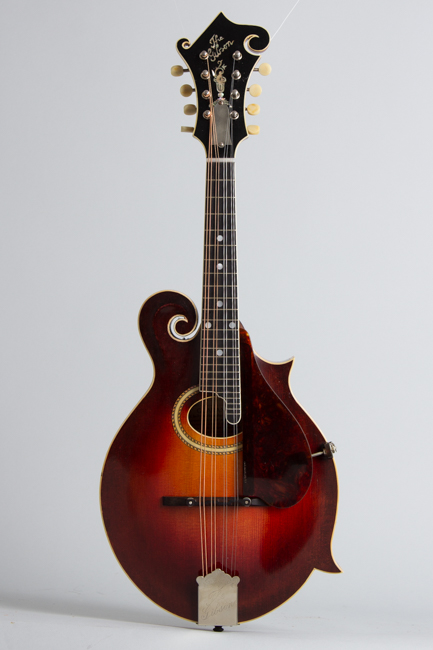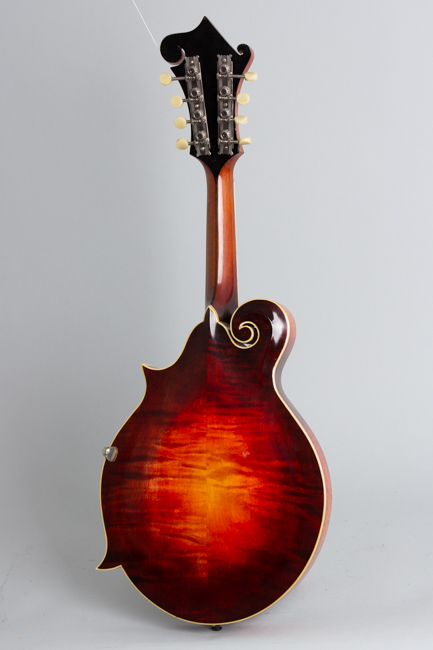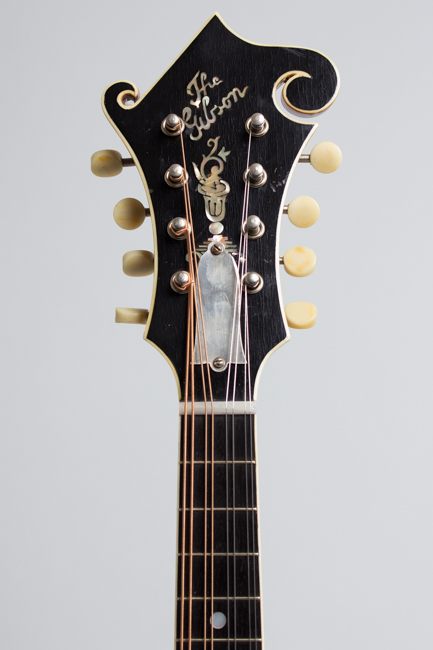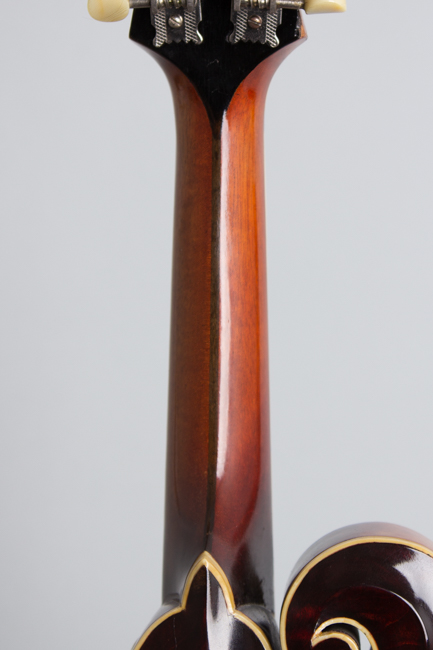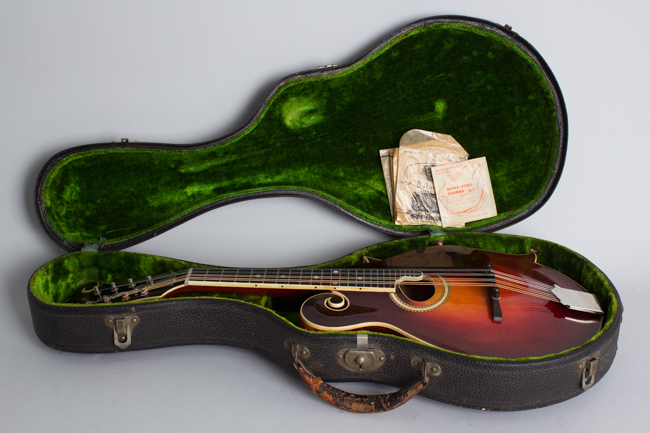Gibson F-4 Arch Top Mandolin (1922)
This item has been sold.
Item # 11935
Prices subject to change without notice.
Gibson F-4 Model Arch Top Mandolin (1922), made in Kalamazoo, Michigan, serial # 69155, red sunburst varnish finish, Male back and sides, spruce top, mahogany neck with ebony fingerboard, original black hard shell case.
As vintage mandolins go there are not too many instruments more revered than an early 1920s Gibson Style F-4 Artist Model. This example was built around the middle of 1922, just as the "Lloyd Loar" period was getting seriously underway at Gibson. It represents a spectacular portrait of Gibson's craftsmanship approaching the apex of the mandolin era, shortly before the company's focus shifted to banjos and then guitars.
Mandolins from this particular time are revered for their beautiful sound, elegant Art Nouveau look and exceptional build quality, the result of 20 years of Gibson perfecting founder Orville's designs. The F-4 Artist's model was Gibson's highest grade mandolin until the advent of the F-hole Master Model F-5 in 1922-3. Even after that $250 model's introduction the F-4 remained priced at $150.00, an extremely expensive and prestigious instrument. The serial number on the label and the Factory order number stamped on the neck block of this mandolin remain clear and date to the first half of 1922, the period just before the F-5 was officially launched.
This F-4 displays several important new features compared to examples from earlier in the year; this was a time of major advances at Gibson. The elaborate scrolled headstock carries the slanted "The Gibson" pearl logo over the original long "flowerpot" inlay that is partially covered by the then *brand* new truss rod cover. The mahogany neck has one of the very earliest adjustable truss rods; it retains the reinforcing ebony strip down the center and is slightly slimmer than 1910's examples with a more subtle but still distinct "V" profile. The cover itself is made of metal, a short-lived appointment before the plastic version was introduced. The bridge is the then new adjustable ebony style, also introduced not too long before.
The two-piece back and sides are made of superb flamed maple; despite Gibson's catalog descriptions, only the Style 4 instruments were actually built with the specified maple body. The entire instrument features a beautiful deep hand rubbed sunburst finish with grained ivoroid binding. Other fittings include a raised tortoise celluloid pickguard with a transitional side clamp, engraved tailpiece cover and the tuners are the special open back strips with elongated shafts on the ends and celluloid buttons. A distinctive touch from this period is a genuine pearl nut.
The venerable F-4 was overshadowed by the new heavily-promoted F-5 after 1923, but examples from the first half of the decade are among the finest ever built and spectacular sounding mandolins. The tone is mellower than Gibson's subsequent F-hole instruments, but with plenty of body and "bite" when needed. This instrument would have been the top choice for any virtuoso mandolinist in 1922, and is still an iconic creation. It has some mostly minor scars from over a century of use but like a fine old violin is a wonderful instrument to play.
Overall length is 26 1/4 in. (66.7 cm.), 10 in. (25.4 cm.) wide at lower bout, and 1 3/4 in. (4.4 cm.) in depth, measured at side of rim. Scale length is 14 in. (356 mm.). Width of nut is 1 3/16 in. (30 mm.).
This mandolin is very clean showing only light wear overall, especially for being just over a century old. The all-original finish shows a lovely patina with only some very minor dings, scratches and dents over the entire instrument. The only oddity is while most of the finish retains excellent color, the entire treble side has faded noticeably from the headstock down to the lower body. Our best guess is the instrument hung for some time where the sun contacted only this area! The back of the neck has some finish worn through the topcoat but no major dings or dents.
There are no cracks or even any evidence of the typical edge seam repairs. The headstock scroll has never suffered any splitting, which is common with these. All the hardware is original and complete including the tuners, tailpiece, early pattern adjustable ebony bridge, raised celluloid pickguard and mounting bracket.
The frets appear to be the original thin wire, crowned down slightly and showing very little wear. The pearl nut is original as well. This is a very sweet and enjoyable mandolin to play with a sparkling sound and a most comfortable action, one of the nicest survivors we have had of the eventful century since Gibson's most venerated era for mandolins. It resides in a nice original hard case, with a few old string packets and such for seasoning. Overall Excellent Condition.
As vintage mandolins go there are not too many instruments more revered than an early 1920s Gibson Style F-4 Artist Model. This example was built around the middle of 1922, just as the "Lloyd Loar" period was getting seriously underway at Gibson. It represents a spectacular portrait of Gibson's craftsmanship approaching the apex of the mandolin era, shortly before the company's focus shifted to banjos and then guitars.
Mandolins from this particular time are revered for their beautiful sound, elegant Art Nouveau look and exceptional build quality, the result of 20 years of Gibson perfecting founder Orville's designs. The F-4 Artist's model was Gibson's highest grade mandolin until the advent of the F-hole Master Model F-5 in 1922-3. Even after that $250 model's introduction the F-4 remained priced at $150.00, an extremely expensive and prestigious instrument. The serial number on the label and the Factory order number stamped on the neck block of this mandolin remain clear and date to the first half of 1922, the period just before the F-5 was officially launched.
This F-4 displays several important new features compared to examples from earlier in the year; this was a time of major advances at Gibson. The elaborate scrolled headstock carries the slanted "The Gibson" pearl logo over the original long "flowerpot" inlay that is partially covered by the then *brand* new truss rod cover. The mahogany neck has one of the very earliest adjustable truss rods; it retains the reinforcing ebony strip down the center and is slightly slimmer than 1910's examples with a more subtle but still distinct "V" profile. The cover itself is made of metal, a short-lived appointment before the plastic version was introduced. The bridge is the then new adjustable ebony style, also introduced not too long before.
The two-piece back and sides are made of superb flamed maple; despite Gibson's catalog descriptions, only the Style 4 instruments were actually built with the specified maple body. The entire instrument features a beautiful deep hand rubbed sunburst finish with grained ivoroid binding. Other fittings include a raised tortoise celluloid pickguard with a transitional side clamp, engraved tailpiece cover and the tuners are the special open back strips with elongated shafts on the ends and celluloid buttons. A distinctive touch from this period is a genuine pearl nut.
The venerable F-4 was overshadowed by the new heavily-promoted F-5 after 1923, but examples from the first half of the decade are among the finest ever built and spectacular sounding mandolins. The tone is mellower than Gibson's subsequent F-hole instruments, but with plenty of body and "bite" when needed. This instrument would have been the top choice for any virtuoso mandolinist in 1922, and is still an iconic creation. It has some mostly minor scars from over a century of use but like a fine old violin is a wonderful instrument to play.
Overall length is 26 1/4 in. (66.7 cm.), 10 in. (25.4 cm.) wide at lower bout, and 1 3/4 in. (4.4 cm.) in depth, measured at side of rim. Scale length is 14 in. (356 mm.). Width of nut is 1 3/16 in. (30 mm.).
This mandolin is very clean showing only light wear overall, especially for being just over a century old. The all-original finish shows a lovely patina with only some very minor dings, scratches and dents over the entire instrument. The only oddity is while most of the finish retains excellent color, the entire treble side has faded noticeably from the headstock down to the lower body. Our best guess is the instrument hung for some time where the sun contacted only this area! The back of the neck has some finish worn through the topcoat but no major dings or dents.
There are no cracks or even any evidence of the typical edge seam repairs. The headstock scroll has never suffered any splitting, which is common with these. All the hardware is original and complete including the tuners, tailpiece, early pattern adjustable ebony bridge, raised celluloid pickguard and mounting bracket.
The frets appear to be the original thin wire, crowned down slightly and showing very little wear. The pearl nut is original as well. This is a very sweet and enjoyable mandolin to play with a sparkling sound and a most comfortable action, one of the nicest survivors we have had of the eventful century since Gibson's most venerated era for mandolins. It resides in a nice original hard case, with a few old string packets and such for seasoning. Overall Excellent Condition.
